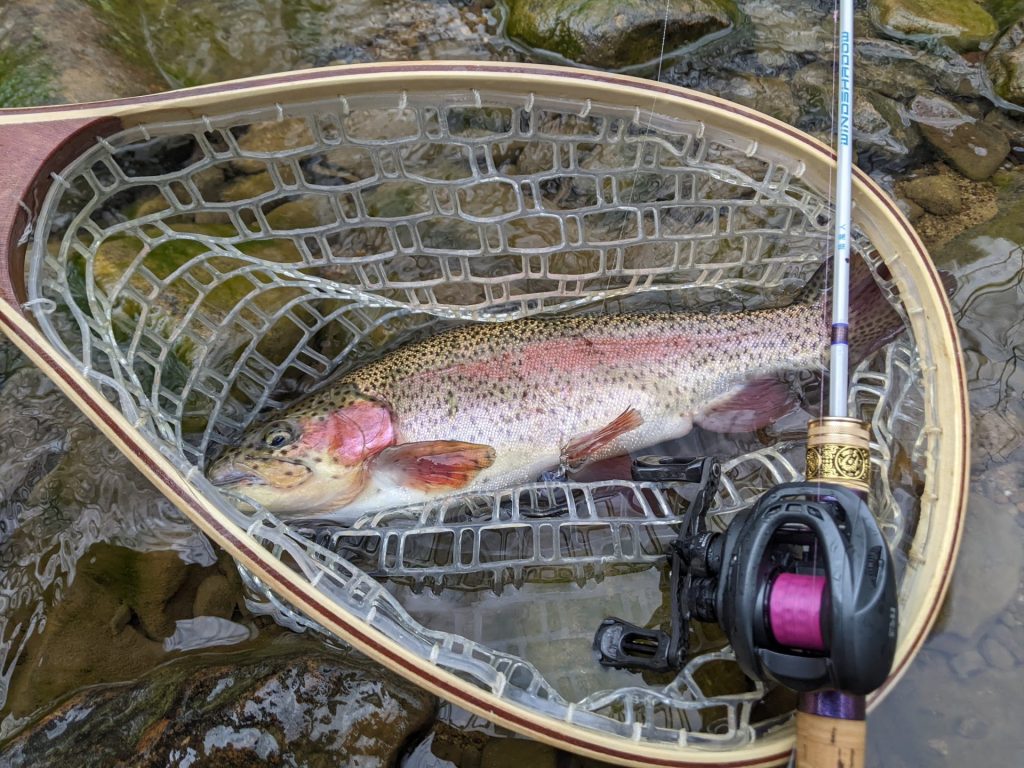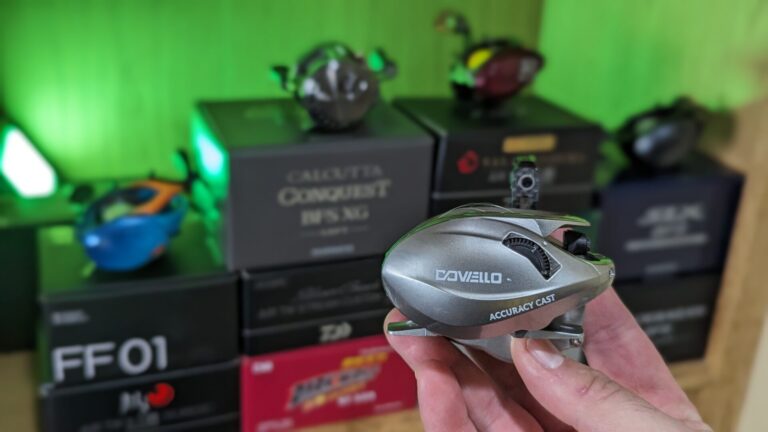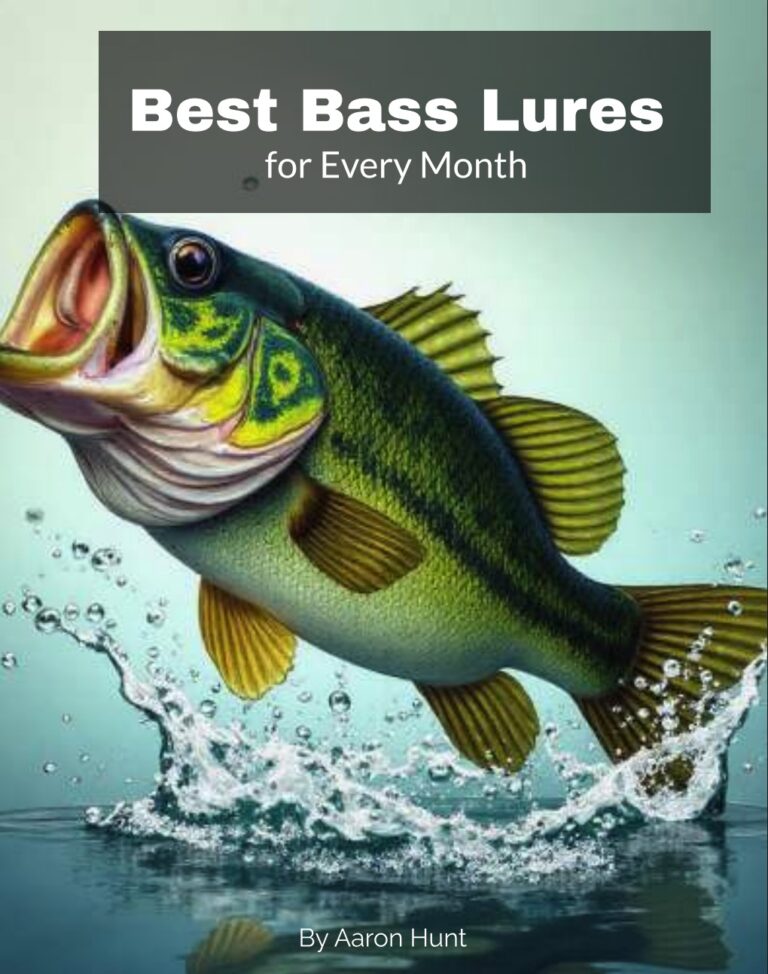Top 3 BFS Fishing Techniques for Beginners to Master
Introduction to BFS Fishing
Hey there, fishing fanatics! If you’re just dipping your toes into BFS fishing, get ready for a wild ride. BFS, short for Bait Finesse System, has opened up new levels of enjoyment and success for anglers in both freshwater and saltwater. I know it almost makes me feel like a kid again when I go fishing. In this article, I’ll share my favorite BFS fishing techniques to help you catch more fish.
Table of Contents
What’s the Deal with Bait Finesse System?
BFS fishing started in Japan, where anglers had to get crafty to catch trout and bass in tricky, highly-pressured waters. The magic of BFS lies in using super light lines, tiny lures, and light reels and rods to make your bait look as natural as possible. Think of it as ultralight baitcasting. Think about it – using bait casters for trout! I never enjoyed trout fishing until I started using BFS.
This setup is perfect for catching fish that are easily scared or just plain picky. With smaller lures and lighter lines, you can make your bait look so real that even the most cautious fish can’t resist. My Personal Best (PB) largemouth bass came from probably the most highly pressured lake in the area. Throwing a tiny minnow on BFS tricked the old giant one April morning.
How BFS Fishing Evolved
The term “BFS fishing” was originally coined discussing trout anglers in Japan, but it didn’t take long for American anglers to catch on, especially those dealing with bass. The need for finesse techniques in crowded fishing spots, along with cool tech like forward-facing sonar, has made BFS a hit in the U.S. And in the last decade, there have been tremendous technology advancements in BFS gear.
Over time, BFS fishing has grown to include all sorts of fish, like crappie and pike. The gear is so versatile that you can switch it up depending on where you’re fishing and what you’re after. This makes BFS a must-have skill for any serious angler.
For more on BFS gear, check out our sections on BFS reels and BFS rod selection.
| Evolution of BFS Fishing | Description |
|---|---|
| Origin | Japan |
| Initial Use | Trout fishing in tricky spots |
| Global Adoption | Bass, crappie, panfish, pike, and trout fishing |
| Tech | Forward-facing sonar, ultralight spools |
By getting the lowdown on BFS fishing’s roots and how it’s grown, you’ll see why this technique and gear are so effective. Whether you’re after bass, crappie, or trout, BFS fishing offers a unique and fun challenge. For more tips and tricks, check out our article on BFS casting techniques.
BFS Reels and Rods
So, you’re thinking about getting into BFS (Bait Finesse System) fishing? Awesome! Let’s break down what makes BFS reels and rods special and how they can up your fishing game.
What Makes BFS Reels Special?
BFS reels are like the sports cars of the fishing world—sleek, light, and built for precision. These baitcasting reels are designed to handle light lines and lures, typically weighing in at less than 6oz. They’re compact, efficient, and perfect for casting ultralight lures without the dreaded backlash.
Ok – backlashes can still happen, but they’re pretty rare in my experience compared to traditional baitcasters.
Here’s what sets BFS reels apart:
- Featherweight Spools: Weighing around 9g or less (some as low as 3 grams!), these shallow spools reduce start-up inertia, making it a breeze for lighter lures to pull the line off the reel.
- High-Tech Brakes: Magnetic brakes and drag clickers give you pinpoint casting and smooth retrieval.
- Micro Bearings: These tiny but mighty bearings keep fine lines from getting stuck, ensuring smooth performance.
Check out the key features:
| Feature | Description |
|---|---|
| Weight | Less than 6oz |
| Spool Weight | Around 9g or less |
| Braking System | Magnetic brakes and drag clickers |
| Bearings | Smooth running micro bearings |
Want more details? Dive into our BFS reels guide.
What’s Cool About BFS Rods?
BFS rods are the perfect partners for BFS reels. They’re usually shorter, with a softer tip and fast action, giving you the sensitivity and control you need for light lures. I have found a softer action rod that maintains a strong backbone is more effective for all-around BFS use than the fast action rods.
But certain applications – like some topwater fishing and some jerk-bait techniques – definitely benefit from a fast action rod. Getting into those application-specific optimizations is why some of us end up with a seemingly endless array of BFS combos. I currently have 18 (I’ve added 2 since this post was written!).
Here’s what makes BFS rods tick:
- Length: Generally between 5′ to 6′, making them shorter than your average rod. My Hunt BFS rods range from 6′ to 7′, as I prefer a longer, softer rod.
- Action: Soft tip for better sensitivity and light lure casting distance.
- Material: Made from high-quality graphite or composite materials for strength and lightweight performance. Some fiberglass models are available.
- Guides: Micro guides reduce line friction and boost casting accuracy.
Here’s a closer look:
| Feature | Description |
|---|---|
| Length | 5′ to 7′ |
| Action | Fast to Moderate with a soft tip |
| Material | High-quality graphite or composite |
| Guides | Micro guides |
Picking the right BFS rod can make or break your fishing trip. Check out our BFS rod selection guide to find your perfect match.
Putting it all Together
Understanding BFS reels and rods is your ticket to mastering BFS fishing. Whether you’re after bass, crappie, or trout, having the right gear can make all the difference. For more tips and gear, swing by our pages on BFS lures and BFS line and leaders.
Happy fishing! 🎣
BFS Fishing Techniques
BFS fishing techniques are becoming a go-to choice for crowded fishing spots and have caught the attention of bass, crappie, and trout anglers across America. You know it’s going mainstream when sites like FishUSA start posting articles about BFS! Let’s dive into three popular BFS fishing techniques: Damiki Rigging, Ned Rigs, and Dropshotting.
Damiki Rigging
Damiki rigging is a killer BFS technique that uses a small jighead with a soft plastic bait. It’s a go-to for bass in cold water or when the fish are feeling the pressure. The trick? Keep the bait hovering just above the bottom, mimicking a dying baitfish. Predators can’t resist.
This technique is very effective with forward facing sonar systems, so I expect to see more and more BFS rigs on boats with the latest fish-finder technology. I even use this technique with Ned rigs when I find myself getting snagged too often.
Wired2Fish has a great tutorial on the Damiki Rig.
| Component | Details |
|---|---|
| Jighead Weight | 1/8 – 3/16 oz |
| Soft Plastic | 2-4 inches |
| Best For | Bass, Trout, Crappie |
Want to know more about BFS gear? Check out our section on bfs rod selection.
Ned Rigging
Ned rigging is another BFS favorite. It involves rigging a short, 3.75″ soft plastic worm on a mushroom-shaped jighead, making the worm stand upright on the bottom. The worm stands upright because it uses plastics that float, like Elaztech. This gives it a unique, enticing action. Ned rig fishing is what originally prompted me to explore BFS fishing techniques as an option for me.
The Ned rig is super versatile and works in various conditions, from open water to heavy cover. Z-man is the biggest name in Ned rigs, but I also use a lot of Mule Fishing products. I even use hellgrammites and other soft plastics on a Ned rig.
The goal is to use as light of a mushroom head as you can. I started with 1/10 and 1/15 oz Ned heads, and now have Mule Jig heads down to 1/80 oz! Can be cast on the right BFS combo. In faster water or with larger plastics, you need the heavier weights. When chasing panfish or in still water, a tiny lure might be the best option.
Why is it called a Ned rig? It was brought to the mainstream by a guy named Ned Kehde. He refers to it as “Midwest Finesse.” He definitely catches a ton of fish each year. So many that I’ve toyed with the idea of only doing Midwest Finesse techniques for an entire year myself.
| Component | Details |
|---|---|
| Plastic Lure Size | 4 inches and less, made from bouyant plastic |
| Weight | Mushroom style, the lighter the better |
| Best For | Bass, Panfish, Trout |
Curious about other BFS baits? Check out our article on bfs lures.
Dropshotting
Dropshotting is a finesse technique where the bait hangs above the weight, moving freely in the water. It’s perfect for fish hanging close to the bottom. The dropshot rig is an ideal BFS fishing technique, letting you use light lines and small baits to tempt those cautious fish.

Most of my childhood I fished a dropshot rig with live bait. We didn’t call it a drop shot back then. It just made sense to us that putting the bait 18-24″ off the bottom made it easier for the fish to eat it – and get hooked! And it can still be an extremely productive approach today.
| Component | Details |
|---|---|
| Hook Size | #2 – #6 |
| Weight | 1/8 – 1/4 oz |
| Best For | Bass, Perch, Trout |
Need tips on line and leaders? Check out my article on bfs line and leaders.
These BFS fishing techniques are just a few of the many tricks up an angler’s sleeve. Practically any small jerkbait, crankbait, or topwater are also staples in any BFS tackle box. But these three techniques are typically thought of as requiring spinning gear. And for many folks, it’s the ability to use a baitcaster for these big-fish techniques that really opens their eyes.
By adding these methods to your fishing toolkit, you can target a variety of species in different conditions. For more on BFS fishing, check out our section on bfs vs. traditional fishing.
BFS Baits and Lures
When you’re into BFS fishing, picking the right baits and lures can become overwhelming. Seemingly an entire new world opens up. As someone who lives and breathes BFS, I’ve discovered that using baits designed for finesse fishing can seriously up your catch rate. Let me share some of my go-to baits: Z-Man Finesse & Micro Series Baits, and Damiki and Drop Shotting Options.
Z-Man Finesse & Micro Series Baits
Z-Man Finesse & Micro Series Baits are almost always in my tackle box. These baits are made for finesse fishing, making them perfect for BFS. They are the original mass-produced Ned rigs, with the “TRD” ned plastics and ShroomZ jig heads. They offer a variety of options, like craws and flukes, which are great for bass, trout, and crappie. I typically get mine from FishUSA. They offer super fast shipping and great prices.
- Shroomz Ned Heads: These jigheads stand up on the bottom, giving your bait a natural look. They’re awesome for smallmouth and largemouth bass.
- TRD Ned Plastics: These are the OG Finesse plastic for me. They don’t call them the “deadly nedly” for nothing.
- Slim Swimz: I’ve had some of my best days for numbers of bass with this plastic. As a bonus, it does well as a ned rig, as a drop shot, or as a Damiki rigged plastic.
- Ned Crawz: Sometimes, the fish just want a crayfish. the Z-man craws are some of the most durable on the market. They don’t get their pinchers bitten off nearly as easily. Plus the buoyant plastic makes them stand up in a very natural-looking defensive position. Put the weight at the tail – not the head.
These baits are super versatile and can be used in various BFS techniques.
Damiki Rig Options
The basics of this rig are the jig-head and the plastic. The effectiveness comes from being able to fish it just above the bottom or above the cover. But I’ll share may favorites of the two pieces of the lures.
- For Jig heads, I like the Z-man Finesse EyeZ
- I also use the Megabass Okashira heads quite often. Yes, they’re a little pricier, but sometimes they make the difference, especially with the Keitech Body.
- For the plastics, The Keitech Fat Swing Impact 2.8 is my go-to. I also like the easy shiner. The downside is, the supple plastic keitech uses can drive fish wild, but sometimes you only get 1 or 2 fish on them. They’re just not very durable.
- My two more durable options are the Z-man Slim Swimz, and a brand I don’t hear anyone talking about: The Fitt Lures Swimbait. Unfortunately, they’ve had some supply issues with their proprietary plastics, so I haven’t been able to get my second-favorite plastic swimbait all year. It was the lure I was using when I completed the PA Black Bass Slam this year. (When they get back into production, I’ll update my link).
Drop Shot Options
For the drop shot, there are three main components: The weight, the hook, and the lure. For me, the hook is the most critical, but the right plastic really matters as well. the weight? Most folks use either a cylinder or a pear-shaped weight. Ideally with a rounded bottom. Tungsten will give you a little more sensitivity (and it’s better for the environment.)
- Drop Shot Hooks
- I have become a HUGE fan of Decoy Brand hooks from Japan. Amazon Usually has them.
- If you can’t find those, the Gamakatsu G-Finesse TW Drop Shot Nano Coated Hook from FishUSA is a solid option as well.
- Drop Shot Plastics
- While you can use something like the Z-man Slim Swimz, the best drop-shot lures are neutrally buoyant, so they hovey more than float
- The Great Lakes Finesse Drop Minnow and Drop Worm are absolutely killer drop shot plastics.
- The KVD Dream Shot Is also a solid choice
- Drop Shot Weight
- the FishUSA Tungsten drop shot weight is as good as any, and a better value. Typically 1/8 oz is enough.
Importance of Line Diameter
Line diameter is a big deal in BFS fishing. Since you’re using light lines and lures, picking the right line diameter is key. Thinner lines mean less resistance, smoother casts, and better lure action. But you gotta balance that with the strength needed for the fish you’re after.
Here’s a table with recommended line strength for different fish:
| Fish Species | Line Diameter (lb test) |
|---|---|
| Crappie | 2-4 lb |
| Trout | 4-8 lb |
| Bass | 6-10 lb |
I use almost exclusively braid with a fluorocarbon leader. For more details, check out my guide on BFS lines.
BFS: More Than Just Bass Fishing
Sure, BFS (Bait Finesse System) is a big hit with bass anglers, but guess what? It’s not just for bass. Since the BFS fishing techniques above are mostly bass-focused, let’s chat about how BFS can up your game with trout too.
BFS for Trout Fans
As I said before, BFS started in Japan to finesse fish in tough conditions, especially for trout. As a trout angler, I love how BFS lets me present light baits naturally, which is crucial for those skittish trout in clear streams. It also lets me make precision casts on a flat trajectory. Pinpoint casts can be the difference between catching and spooking a trout.

Best BFS Lures for Trout
- Micro Jerkbaits: I prefer something suspending like the Dynamic Lures HD trout
- Inline Spinnerbaits: These almost always produce. Lures like the Panther Martin or the ARS Spinner are my first choice.
- Crankbaits: Covers more water and triggers reaction strikes from aggressive trout. But I find the can also spook fish because of the amount of noise and commotion the make as the dig along the bottom.
- Damiki Rig: yes, I said it’s mainly a bass technique, but BIG trout can be taken on something like the Keitech Fat Swing Impact fished like a Damiki Rig
Need tips on BFS gear? Visit our Choosing the Right BFS Gear section.
| BFS Technique | Trout Success Rate |
|---|---|
| Mirco Jerkbaits | High |
| Inline Spinners | High |
| Crankbaits | Medium |
| Damiki Rig | Lower, but usually Trophy-Sized |
BFS fishing isn’t just versatile; it makes fishing more fun. By tweaking your techniques and gear, you can use BFS for both crappie and trout, boosting your chances of success. For more on BFS, check out our articles on BFS in Freshwater and BFS in Saltwater.







